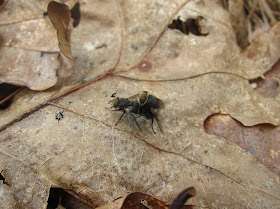The first one we saw was a Canada Goose, all snuggled in among fluffy down, pulled from her own soft breast.
The second one we saw was an Osprey so far down in her nest we weren't sure at first there was really a bird in there. Or even if that skimpy pile of sticks on the old bridge piling could really be a nest. But later she stuck her head up where we could see her. (And later still, she and her mate treated us to spectacular views of the two of them wheeling and soaring over the river.)
So those were the birds, and here were the . . . well, they kind of look like bees, even though they're Tachinid Flies, doing the "birds and bees" thing. As adults, Tachinid Flies are kind of nice, they don't bite or sting and they eat mostly pollen and they're kind of furry and have big brown eyes. Their babies, though, we might find a little creepy, since Tachinid larvae parasitize other insects, especially our beloved Monarch caterpillars. Ah well, all God's chillen gotta eat.
Speaking of babies, I found quite a few in the Skidmore woods today, although they were neither birds nor bees (or flies), but rather, baby plants.
This Wood Betony baby was so small, a quarter might have covered it. I love its red crinkly leaves, set off so prettily here in a bed of fruiting moss.
This wee little fern was uncoiling among the limestone rocks that litter the forest floor. I do not know its species, but it's one with a dark red rachis.
Both the new-born leaves and the opening flowers of Wild Ginger are covered with baby-soft down.
The pale-green flower bud of Mayapple hides among its enfolding unfurling leaves, like a chick snuggled down in a nest.
Wait! This is not a baby Hepatica, with its tattered leaves and with flowers already going to seed.
Yes, but look down in the center of this plant, where the new leaves have just emerged, all fresh and tender and covered with down, as soft and fluffy as any baby kitten or chick.











So beautiful! I love the way you were able to photograph the birds on the nest. And you always make us take a closer look. Many of the plants and flowers you mention don't seem to be out yet where I go, or perhaps I am not looking closely enough....
ReplyDeleteLove the post. Great eye!
ReplyDeleteMy friend Margaret told me about your blog -- it is indeed awesome. Have you already revealed what camera you use? I would appreciate knowing. I write from eastern Kentucky, with my own weekly blog (Sideway Views). It's amazing how often and beautifully you post. Thank you so much. Ann
ReplyDeleteThe red rachis of the Bulblet Fern,Cystopteris bulbifera is diagnostic in the early spring. As it is a lime lover it grows with many of my favorite spring ephemerals.
ReplyDeleteThanks, Virginia, for your kind comments about the bird photos. I often wish I had a camera with a better zoom so I could get clearer shots from far away, but I stick with my little pocket camera because I'm not willing to tote any camera that's bigger and heavier.
ReplyDeleteThanks, Raining Iguanas. We sure live in a wonderful place for looking with open eyes.
Welcome, Ann, and thanks for stopping by so we can visit your blog by clicking on your name. My camera is a Canon PowerShot S95, about the size of a deck of cards that can easily slip into my pocket but which serves me well when I have to hike or climb some distance, or when I have to use one hand to anchor myself on a streambank or mountainside while taking photos with the other hand. I appreciate your kind comments.
Thanks for your input regarding the fern, Rattlesnake Cobble. I know that Bulblet Fern loves lime, and I've often found it on limey substrates and noticed its little round "bulblets." I shall have to check on these ferns when they are old enough to reproduce.